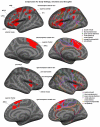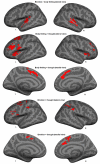States of mind: emotions, body feelings, and thoughts share distributed neural networks
- PMID: 22677148
- PMCID: PMC3453527
- DOI: 10.1016/j.neuroimage.2012.05.079
States of mind: emotions, body feelings, and thoughts share distributed neural networks
Abstract
Scientists have traditionally assumed that different kinds of mental states (e.g., fear, disgust, love, memory, planning, concentration, etc.) correspond to different psychological faculties that have domain-specific correlates in the brain. Yet, growing evidence points to the constructionist hypothesis that mental states emerge from the combination of domain-general psychological processes that map to large-scale distributed brain networks. In this paper, we report a novel study testing a constructionist model of the mind in which participants generated three kinds of mental states (emotions, body feelings, or thoughts) while we measured activity within large-scale distributed brain networks using fMRI. We examined the similarity and differences in the pattern of network activity across these three classes of mental states. Consistent with a constructionist hypothesis, a combination of large-scale distributed networks contributed to emotions, thoughts, and body feelings, although these mental states differed in the relative contribution of those networks. Implications for a constructionist functional architecture of diverse mental states are discussed.
Copyright © 2012 Elsevier Inc. All rights reserved.
Figures




Similar articles
-
The Social Brain Automatically Predicts Others' Future Mental States.J Neurosci. 2019 Jan 2;39(1):140-148. doi: 10.1523/JNEUROSCI.1431-18.2018. Epub 2018 Nov 2. J Neurosci. 2019. PMID: 30389840 Free PMC article.
-
Differential recruitment of theory of mind brain network across three tasks: An independent component analysis.Behav Brain Res. 2018 Jul 16;347:385-393. doi: 10.1016/j.bbr.2018.03.041. Epub 2018 Mar 28. Behav Brain Res. 2018. PMID: 29604366
-
Supramodal representations of perceived emotions in the human brain.J Neurosci. 2010 Jul 28;30(30):10127-34. doi: 10.1523/JNEUROSCI.2161-10.2010. J Neurosci. 2010. PMID: 20668196 Free PMC article.
-
A functional architecture of the human brain: emerging insights from the science of emotion.Trends Cogn Sci. 2012 Nov;16(11):533-40. doi: 10.1016/j.tics.2012.09.005. Epub 2012 Oct 2. Trends Cogn Sci. 2012. PMID: 23036719 Free PMC article. Review.
-
Large-scale brain networks in affective and social neuroscience: towards an integrative functional architecture of the brain.Curr Opin Neurobiol. 2013 Jun;23(3):361-72. doi: 10.1016/j.conb.2012.12.012. Epub 2013 Jan 23. Curr Opin Neurobiol. 2013. PMID: 23352202 Free PMC article. Review.
Cited by
-
Mechanisms linking individual and organizational culture change through action research: Creating change agents for organizational and food safety culture development.Heliyon. 2023 Jan 19;9(2):e13071. doi: 10.1016/j.heliyon.2023.e13071. eCollection 2023 Feb. Heliyon. 2023. PMID: 36747535 Free PMC article.
-
The ENGAGE study: Integrating neuroimaging, virtual reality and smartphone sensing to understand self-regulation for managing depression and obesity in a precision medicine model.Behav Res Ther. 2018 Feb;101:58-70. doi: 10.1016/j.brat.2017.09.012. Epub 2017 Oct 7. Behav Res Ther. 2018. PMID: 29074231 Free PMC article.
-
Interoception in Old Age.Brain Sci. 2022 Oct 17;12(10):1398. doi: 10.3390/brainsci12101398. Brain Sci. 2022. PMID: 36291331 Free PMC article.
-
If it bleeds, it leads: separating threat from mere negativity.Soc Cogn Affect Neurosci. 2015 Jan;10(1):28-35. doi: 10.1093/scan/nsu007. Epub 2014 Feb 3. Soc Cogn Affect Neurosci. 2015. PMID: 24493851 Free PMC article.
-
Shared states: using MVPA to test neural overlap between self-focused emotion imagery and other-focused emotion understanding.Soc Cogn Affect Neurosci. 2017 Jul 1;12(7):1025-1035. doi: 10.1093/scan/nsx037. Soc Cogn Affect Neurosci. 2017. PMID: 28475756 Free PMC article.
References
-
- Adolphs R, Gosselin F, Buchanan TW, Tranel D, Schyns P, Damasio AR. A mechanism for impaired fear recognition after amygdala damage. Nature. 2005;433(7021):68–72. - PubMed
-
- Adolphs R, Tranel D, Damasio H, Damasio A. Impaired recognition of emotion in facial expressions following bilateral damage to the human amygdala. Nature. 1994;372(6507):669–672. - PubMed
-
- Adolphs R, Tranel D, Hamann S, Young AW, Calder AJ, Phelps EA, et al. Recognition of facial emotion in nine individuals with bilateral amygdala damage. Neuropsychologia. 1999;37(10):1111–1117. - PubMed
Publication types
MeSH terms
Grants and funding
LinkOut - more resources
Full Text Sources
Other Literature Sources

